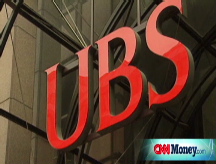Grim outlook for banks, profits down 46%
Financial sector earnings fall and number of 'problem banks' rises to highest in nearly four years, FDIC reports.
NEW YORK (CNNMoney.com) -- The mortgage meltdown and credit crunch continued to take their toll on the battered financial industry in the first quarter, according to a government report on the banking sector released Thursday.
Bank profits plummeted 46% over the same period last year, while the number of banks at financial risk rose to 90 from 53.
The Federal Deposit Insurance Corp., which insures bank deposits of up to $100,000, reported that financial institutions earned $19.3 billion in the quarter, down from $35.6 billion in the first quarter of 2007.
Profits were much better than they were in the fourth quarter of 2007, when banks earned a total of $600 million. But FDIC Chairwoman Sheila Bair said at a press conference that the fourth quarter set a "pretty low bar."
First-quarter earnings were weak because the quality of home loan assets continued to deteriorate amid a battered housing market. Financial institutions also dedicated more money to cover potential losses as the fallout from bad subprime loans and the continuing credit crisis put pressure on banks' bottom lines.
"What we're seeing is continued questions about the banking sector and fewer answers," said Matt McCormick, bank analyst and portfolio manager at Bahl & Gaynor Investment Counsel. "I don't see that abating anytime soon."
FDIC-insured banks set aside $37.1 billion in loan-loss provisions during the quarter - four times more than the $9.2 billion in the first quarter of 2007. The first-quarter provisions ate up 24% of the industry's net operating revenue in the quarter, up from only 6% a year ago.
"The consumer is getting pushed around on all sides, with higher gas costs, less available credit, and fewer jobs," said McCormick. "When you look at that environment, it's not a good time for banks to loan money."
Though the opposite is true for the consumer, banks count loans as assets because they charge borrowers interest. With difficult lending conditions in the slumping economy, McCormick believes the financial sector will continue to be volatile throughout 2008 and into 2009.
The FDIC said 90 banks - or 1.1% of those it regulates - were on its "problem bank list" in the first quarter, up from 53 in the first quarter of 2007 and 76 in the fourth quarter.
"The number of problem banks is rising, but from an almost non-existent level," said FTN Midwest Research analyst Peyton Green. "We will see this start to accelerate and then continue for some time."
But not all problem banks are doomed to fail. In fact in 2007 only three banks failed, even though 50 were on the watch list at the end of the previous year. So far this year, three more banks have failed.
Still, the number of banks at risk is now the highest since the third quarter of 2004. The past quarter was the sixth straight quarter in which the number of problem banks has increased. The number of problem banks were at an all-time low of 47 in the third quarter of 2006.
By comparison, Bair noted that in the early 1990s, about 10% of banks were on the FDIC's problem list. She added, however, that the number of problem banks should continue rising in the months ahead since there are growing credit quality problems.
"Without a doubt, we'll see some closures this year," said Green.
Another troubling sign is that industry reserves failed to keep pace with the rising number of troubled loans. The ratio of reserves to noncurrent loans fell to a fifteen-year low.
"This is a worrisome trend - it is the kind of thing that gives regulators heartburn," said Bair. "Given the weaker economy and rising level of problem loans, we're urging all institutions to make sure their reserves are large enough to cover expected losses."
Bair also urged banks to beef up their capital cushions beyond regulatory minimums, due to uncertainties about the housing market.
Since real estate collateral represents 60% of all bank assets, according to Green, he said that we're a long way from seeing stabilization in the bank sector.
"Real estate loans aren't just 'an' issue, it's 'the' issue," he said. "This is going to take some time to play out." ![]()


